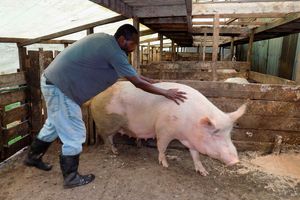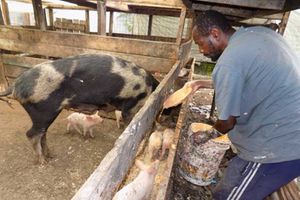
Animals may also get infected because they have reduced immunity.
There have been many occasions where farmers have told me that farm animals should not get sick from eating unhygienic feed because they are used to feeding on uncooked food from the environment, where disease-causing organisms or pathogens are in plenty.
The assertion may appear logical, but proper understanding of how the animal body works and how animals interact with their environment debunks the claim. The environment is generally described as everything else except the subject. The animal interacts with environmental physical, chemical and biological factors.
All animal feeds, including water, contain pathogens that may cause diseases in animals. Processed feeds have less pathogens than raw unprocessed feeds. Animals usually do not get sick by eating pathogens in feeds or in water because of several reasons.
First is that not all micro-organisms in feeds cause diseases. Many are even beneficial to the animals’ body systems including the digestive, reproductive, respiratory, urinary tracts and even the ear canal. All these body canals have direct contact with the environment from where micro-organisms may get access. In fact, the digestive system is technically considered to be part of the animal’s environment because it starts from the mouth and continues as one canal down to the anal opening. It also takes in lots of materials containing large numbers of micro-organisms.
Second, infective micro-organisms all have the minimum number that must be consumed to cause infection. This is called the minimum infectious dose. Finally, over time, animals develop immunity to infection by some micro-organisms and therefore will resist infection even if the micro-organisms are consumed in large numbers. Resistance can also be acquired through routine vaccination of animals.
Despite all the reasons I have given on why animals may consume micro-organisms and not get infected, infection occurs when the minimum infectious dose is consumed, when micro-organisms may be highly infectious or even when the micro-organisms are new and the animal’s body has no immunity against the pathogens. Animals may also get infected because they have reduced immunity.
This article is motivated by an interesting case I encountered last week. Ngoto, a paravet in Narok, called me and said he had some unusual case involving pigs. He said the animals had been fine the previous day, but in the morning, they woke up with several pigs limping on one or more legs.
He sent me photos and videos of the pigs walking. I confirmed they were limping from the lower legs at the feet level and the first joint above the hoof. I have worked long distance with Ngoto for a long time, but had not encountered a similar case. Ngoto further told me some of the young pigs deteriorated quickly and died.
I advised him to check the temperature of the pigs and also examine the lower legs and hooves, take photos and share immediately. I also advised him to check whether the farm had recently made any changes to their management protocols. He would also observe the location of the farm and share the findings with me.
Ngoto got back to me with his findings and they were quite interesting. The pigs had an average temperature of 40.5 degrees Centigrade, meaning they had elevated temperature. When I checked the photos, Ngoto had found a button-like wound on the tongue of one sick pig.
Some pigs had raw red wounds at the junction of the skin and the hooves. Other limping pigs had very reddened skin at the junction of the skin and the hoof. These findings indicated the pigs had foot and mouth disease (FMD).
The next set of findings further strengthened my FMD diagnosis. Ngoto reported the farm was located about 200 metres from a cattle slaughterhouse. The farm owner said he had recently started feeding the pigs with water from the water trough at the slaughterhouse. This is the same water that slaughter cattle drunk from directly. This was circumstantial evidence that the pigs indeed had an FMD attack.
Although the area had not reported an FMD outbreak, some cattle are known to harbour the FMD virus long after they have recovered from an infection without showing illness. This is called an FMD carrier state. Such animals may have transmitted the disease to the pigs through the drinking water.
FMD carrier state is a significant concern in the control of the disease, as it can persist for extended periods and complicate efforts to achieve FMD control. FMD is a disease caused by the FMD virus in cloven-hoofed animals, including pigs. It has no specific treatment but is effectively controlled by vaccination every six months. The disease causes heavy economic losses to farmers by stopping trade, death of animals, wasting of sick animals with some failing to recover body condition. I advised Ngoto to report the outbreak to the Narok sub-County veterinary officer as required by the law.
I also advised him to tell his client to stop using the slaughterhouse water. I always advise farmers to ensure they get feeds and water from highly reputable sources.








